The AMD Trinity Review (A10-4600M): A New Hope
by Jarred Walton on May 15, 2012 12:00 AM ESTAMD Trinity: Battery Life Also Improved
With all of the changes going into Trinity, one thing that hasn’t changed since Llano is the process technology. Trinity is once again coming on a 32nm process from GlobalFoundries. If we were talking about Intel, Trinity would represent a “Tock” on the roadmap—a new architecture on an existing process. We’ve looked at CPU and GPU performance, and this is a part that’s pretty much universally faster than its predecessor. Given the lengthier pipeline and Bulldozer-derived architecture, I admit that I was concerned Trinity might actually be a step back for battery life; it appears that my fears were unfounded, largely due to the improvements in Piledriver. As usual, we tested with all laptops set to 100 nits brightness in our idle, Internet, and H.264 playback tests. I also ran some additional tests which we’ll discuss in a moment. First, here are the standard battery life results:
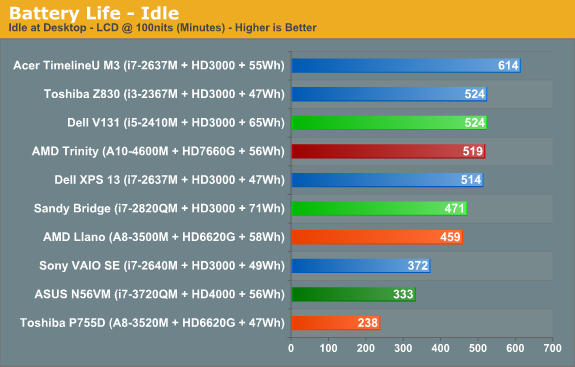
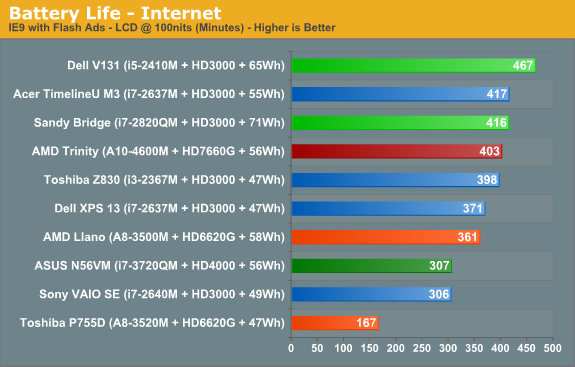
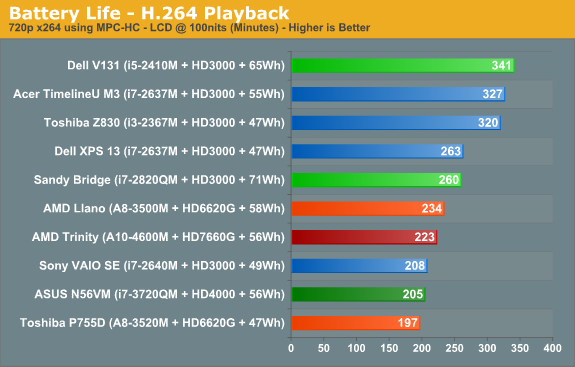
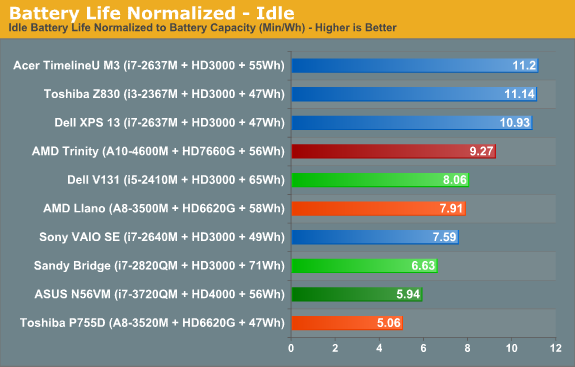

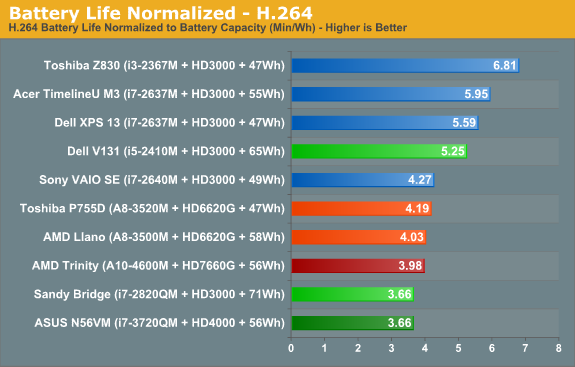
With a similar capacity battery to the original Llano laptop, and the same size 14” panel, Trinity comes out of the gates and posts two clear wins: idle battery life and Internet battery life are both up substantially relative to Llano. In fact, looking at the normalized charts, the only laptops that can consistently beat Trinity are found in Sandy Bridge ultrabooks—we won’t even bother discussing Atom or Brazos netbooks, as they’re competing in a completely different performance bracket. In something of a surprise, H.264 battery life doesn’t see the same benefit unfortunately, and it’s the one discipline where Llano still holds on to a slight lead over Trinity. Sandy Bridge meanwhile has always done very well in H.264 battery tests, and we see that with the Vostro V131 posting a normalized score that’s 30% better than Trinity and Llano. Of course, on the other end of the spectrum we have Ivy Bridge; we’ve only looked at one Ivy Bridge laptop so far, but if the pattern holds than Ivy Bridge will generally be a moderate step back in battery life relative to Sandy Bridge, giving AMD an even larger lead in this area.
We also performed a few other tests that we won’t present in graph form. One set of tests we alluded to earlier: the charts show Trinity with a Samsung 830 SSD, but we also ran tests with an Intel 520 SSD. Idle battery life dropped to 476 minutes (an 8% decrease), Internet battery life checked in at 371 minutes (down 8% again), and H.264 battery life stayed nearly the same at 217 minutes (down less than 3%). If battery life is one of your primary concerns, remember: all SSDs are not created equal!
Another test that we ran is simulated gaming; we looped the four graphics tests in 3DMark06 at 1366x768 until the battery ran out. We’ve run this same test on quite a few other laptops, and Llano initially looked to be far and away the best solution. Later, we discovered that when we tested Llano we were letting the GPU run in power saving mode—basically half the performance you’d get compared to being plugged in. We retested and measured 98 minutes, so the extra graphics performance comes with a heavy cost. We only tested Trinity (and Ivy Bridge and Sandy Bridge) using higher performance graphics settings, and this is one more area where it scores worse than Llano: Trinity managed just 77 minutes. That’s about the same as Ivy Bridge and Sandy Bridge (79 and 73 minutes, respectively), so if you’re after better gaming performance while running off the mains, you might need to keep looking.
Before getting too carried away with the above results, you still need to consider how important battery life is for your usage model. Some people travel a lot and like to go all day without plugging in; others will go from place to place and plug in whenever they’re not on the go. If you fall in the latter category, battery life isn’t usually a problem with any decent laptop, while those looking for all-day computing will definitely want as much mobility as possible. Ultimately, battery life is a factor of battery capacity as well as power optimizations done by the OEMs. We’ve seen battery life improve by as much as 50% when comparing two otherwise similar notebooks, but at least AMD’s reference platform for Trinity delivers a great starting point.
Temperatures and Acoustics
One other item we wanted to quickly touch on is system temperatures. We typically use HWMonitor and check temperatures of laptops under idle and load conditions. We did this with Trinity as well, but unfortunately the current version of HWMonitor doesn’t give us a lot of information. The only temperatures it reports are from the SSD and the HD 7660G graphics—there’s nothing about CPU core temperatures. That means we can’t provide much detail, other than to say that load temperature on the GPU topped out at 71C during extended testing, while the idle temperature was 39C. As usual, temperatures and noise levels go hand in hand, and the low 71C maximum GPU temperature matches up nicely with noise levels that never got above 37dB. It’s not the quietest laptop we’ve ever tested, and surface temperatures can get a little warm, but overall Trinity looks to be a good balance of performance and power requirements, which means quiet laptops are definitely possible.










271 Comments
View All Comments
zepi - Tuesday, May 15, 2012 - link
You've got it backwards.Stuff is priced according to the value it has for customers. To get as much money from their product as possible, regardless of manufacturing costs. Or that's what everybody is aiming for. Trinity is going to be cheap only because it's not good enough to get sales if priced higher.
Best possible outcome for everybody would have been that cheapest Trinity-based laptops would cost about $1500, but they'd be about as fast as Ivy Bridge Quadcore-desktops with Geforce GTX680 and still achieve a battery-life of about 8min per Wh. And performance & price would both have only gone upwards from there on.
That kind of performance-dominance would force Intel and Nvidia to drop their prices considerably (getting us the cheap laptops regardless of trinity being pricey) and we'd still have to option to go for über Trinity's if we'd have the cash.
And it would save AMD from bankruptcy, ensuring that we'd have competition in future as well.
Llano, Brazos and Bulldozer are all horrible products for AMD. Good product is characterized by the fact, that it has considerably more worth to the customer than it costs to manufacture it. If a product is good, it's easy to price it accordingly, and people will still buy it. AMD's CPU's are apparently very bad products, because AMD is making huge losses at the moment. And I don't think it's the GPU-division that's causing those losses.
JarredWalton - Tuesday, May 15, 2012 - link
Products are priced according to where the marketing folks think they'll sell. All you have to do is walk into Best Buy and talk to a sales person to realize that they'll push whatever they can on you, even if it's not faster/better. And I think the bean counters feel they can sell Trinity at $700 or more--and for many people, they're probably right. We'll see $600 and $500 Trinity as well, but that will be the A8 and A6 models, with less RAM and smaller HDDs.As far as competition, propping up an inferior product in the hope of having more competition isn't healthy, and if AMD has a superior product they simply charge as much as Intel. NVIDIA is the same. If someone came out with a chip that had the CPU performance of IVB and the GPU performance of a GTX card, all while using the power of Brazos...well, you can bet they'd charge an arm and a leg for it. They wouldn't sell it for $1500, they'd sell it for $2500--and some people would buy it.
Ultimately, they're all big businesses, and they (try to) do what's best for the business, so I buy whatever product fits my needs best. I wish Trinity were more impressive, particularly on the CPU side of the equation. I think if Trinity's CPU were as fast as Ivy Bridge, the GPU portion would probably end up being 50% faster than HD 4000; unfortunately, there are titles that require more CPU work (Skyrim for instance) and that starts to level the playing field. But wishing for something that isn't here, or playing the "what if" game, just doesn't really accomplish anything.
Targon - Wednesday, May 16, 2012 - link
And you can get a quad-core A6 laptop for under $500 right now. If you pay attention, you generally get what you pay for. For most users, going with an AMD quad-core laptop does provide a decent product for the price. For some, CPU power is more important, and for others, a more well rounded machine is more important. I expect that A10-4600 laptops will start closer to $600 than $700, unless you are looking at machines with a large screen, discrete graphics, or something else that increases the prices.CeriseCogburn - Wednesday, May 23, 2012 - link
What you're all missing is all the then second tier Optimus laptops that will have much deflated pricing, as well as the load of $599 amd discrete laptops that will sell like wildfire and please those who waited - just like the amd fans are constantly waiting for nVidia to release so they can snag a second tier deflated price amd card.Since the "cpu doesn't matter !" as we have been told, there's no excuse to not snag a fine and cheap Optimus that won't have an IB.
This is the "best time in the world" for all the amd fans to forget all prior generations of laptops and pretend, quite unlike in the video card area, that nothing else exists.
I love how amd fans do that crap.
evolucion8 - Tuesday, May 15, 2012 - link
Also remember that Penryn was launched on 2007-2008 and until late 2009, several Core 2 Duo laptops were released. I have a Gateway MD7309u and it was launched on October 2009 and still feeling very snappy and has good battery life, I hate its GMA 4500M with my whole heart.....Nfarce - Tuesday, May 15, 2012 - link
Yeah well I don't understand the point of buying a low-mid range laptop expecting to be enjoying playing games at basic laptop 1366x768 resolutions. What's the point?You can spend around $1,200 on a mid-range i5 turbo boost laptop with a discreet GPU and 1600x900 resolution screen that plays games decently without completely shutting down the eye candy sliders. Save up and get a better laptop - and Intel with a dedicated AMD or Nvidia GPU. If you can afford $600 now, you can afford $1,200 down the road and enjoy things much better.
CeriseCogburn - Wednesday, May 23, 2012 - link
I agree but the famdboy loves to torture itself and claim everyone else loves cheap frustrating crap - often characterized as a "mobile employee on the road, in the airplane, or at the hotel spot" needing a "game fix"...(in other words someone flush enough to buy +discrete) as you pointed out.The rest of the tremendous and greatly pleased "light gamers" will purportedly be playing at work( no scratch that) or on their couch at home (that sounds like the crew) ... and then one has to ask why aren't they using one of the desktops at home for gaming... a $100 vidcard in that will smoke the crap out of "the light gamer".
That leaves "enthusiasts" who just want to play with it and see for a few minutes if they can OC it, and "how it does" with games... and after that they will want to throw it at a wall for how badly it sucks - not to mention their online multi-player avatar will get smoked so badly their stats will plummet... so that will last all of two days.
So we get down to who this thing is really good for - and I suppose that's the young teen to pre teen brat - as a way to get the kid off mommy's or daddy's system so they can have the reigns uninterrupted... so the teeny bopper gets the crud low $ cheap walmart lappy system that should also keep them tamed since being too rough with it means the thing snaps in half a the plastic crumbles.
Yep - there it is - teeny bopper punkster will just have to live with the jaggied pixelized low end no eye candy crawler - and why not they still love it much more than homework and have no problem eyeballing the screen.
Latzara - Tuesday, May 15, 2012 - link
While i agree with the 'nothing earthshattering' part I have to wonder what kind of average Internet browsing usage are you commenting on when you say 'People want their laptop to be responsive when doing work, watching movies and browsing' -- Most of the CPUs on the entire board presented here are enough for work - not graphics modelling mind you - excell, DB, mail, presentations, average calculation load, and even smaller programming projects - which constitutes most of the workload an average worker is gonna get, movies stopped being an issue way before, and what kind of browsing are we talking about that will make your platform unresponsive (i don't mean frozen)? 25 tabs at once? Cause i've done that with a much weaker platform and had no issues...The main problem i see is that the plaform hasn't moved as much as ppl hoped, but enough to be a new iteration in terms of progress - and with the right pricing it could be the sweet spot for many of the broader average consumers - not just the '1% of the 1% of people looking for great gaming" ...
BSMonitor - Tuesday, May 15, 2012 - link
Load up a couple Java runtime environments in those browsers. Some flash. I did have an etc in there. I am a multi-tasker, and cannot stand waiting any amount of time. For the majority of real laptop owners, a late Pentium M, Athlon 64/X2, is not enough power for any real work.Spunjji - Wednesday, May 16, 2012 - link
Please define a "real" laptop owner? I own an Alienware and I don't do any of that sort of crap. Mind you, most users I have met express more patience than you do, too. regardless, in none of these metrics do you appear to represent the majority, which is the target market for this chip.